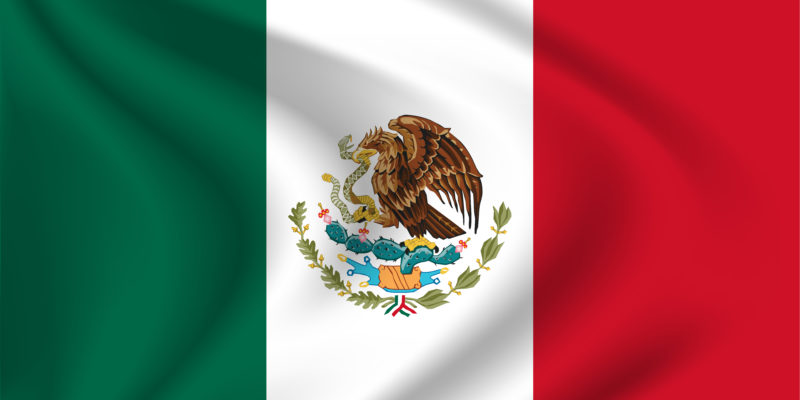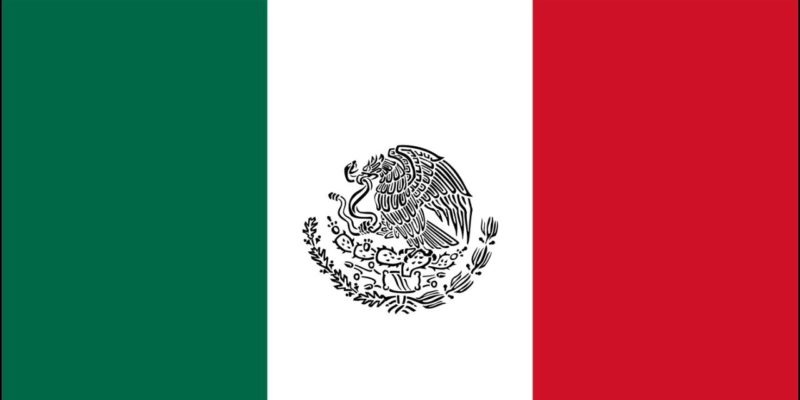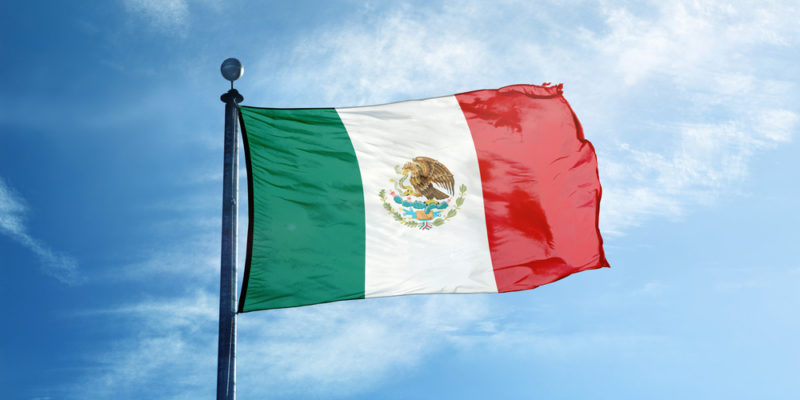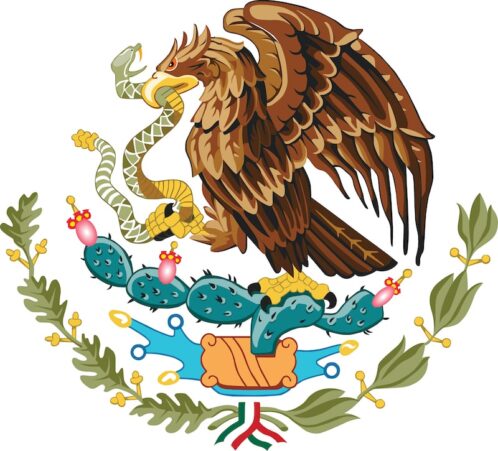Table of Contents
We explain everything about the flag of Mexico, what its colors and coat of arms represent, as well as the history and characteristics of the national anthem and emblem.

What does the flag of Mexico look like?
The flag of Mexico is one of the national symbols of the Republic of Mexico. It is a rectangle divided into three vertical stripes of green, white, and red. In the center of the white stripe, it bears the national coat of arms.
This emblem serves as a symbol of identity for Mexicans as it brings together the values of the nation. It was first raised in 1821, and Flag Day (Día de la Bandera) is celebrated every February 24. Its current version was officially adopted in 1968.
The flag, together with the coat of arms and national anthem, is one of the symbols of Mexican identity. Its characteristics and protocol are specified in the Law on the National Coat of Arms, Flag and Anthem enacted in 1984.
- See also: Mesoamerican civilizations
Characteristics of the Mexican flag

Some characteristics of the Mexican flag are:
- Along with the coat of arms and the national anthem, it is one of the national symbols of Mexico.
- It is composed of three vertical stripes of green, white and red.
- In the center is the coat of arms of Mexico, which bears an eagle perched on a nopal cactus.
- Its colors have their origin in the Army of the Three Guarantees’ flag (Ejército Trigarante) of 1821.
- It was officially adopted in 1968.
- Flag day (Día de la Bandera) is celebrated on February 24, when the Pledge of Allegiance to the flag is taken in Mexican schools.
- It has a height-to-length ratio of 4:7.
- There is a flag for official use and another for civil use. The official flag bears the coat of arms in color, while the civil flag displays the emblem in black and white or shades of gray.
Origin and history of the Mexican flag
In pre-Columbian times there was no concept of flag as is understood today. However, a type of pictography did exist representing each of the pre-Columbian cultures (in the case of the Mexica, it was the image of a nopal cactus).
The first record of the tricolor Mexican flag appeared in 1821, when the Army of the Three Guarantees (Ejército Trigarante) led by Agustín de Iturbide fought for Mexican independence against the Spanish troops. This design already included the figure of the eagle perched on a nopal cactus, as well as the crown of the Empire and the coat of arms in the center, although the eagle did not appear as on the current flag with a snake in its beak.
The design of the flag underwent minor modifications throughout the 19th and 20th centuries, especially concerning the elements that make up the emblem. Variations continued until 1968, when the current Mexican flag was officially adopted. In 1984, a law was passed stipulating the official characteristics of the flag, the national anthem and the coat of arms.
Colors of the flag of Mexico

Although the colors of the Mexican flag have remained unchanged since 1821, the meaning each of them symbolizes has changed over time.
Initially, white represented religion and people’s faith in the Catholic Church; red represented unity, making reference to the ties between Americans and the growing wave of immigrants; and green symbolized the freedom and independence of the Mexican people from the Spanish.
Nowadays the meaning of the colors has changed: green represents hope, white symbolizes unity, and red stands for the blood of fallen fighters.
Pledge of Allegiance to the Mexican Flag
Though not part of the official protocol established by the 1984 law, the Pledge of Allegiance ceremony is a significant event in schools throughout Mexico. It takes place every February 24 when boys and girls recite the following oath:
Flag of Mexico!
legacy of our heroes
symbol of the unity
of our parents
and our brothers,
we promise to be always be faithful
to the principles of freedom and justice
that make our Homeland
the independent,
humane and generous nation
to which we give our existence.
¡Bandera de México!
Legado de nuestros héroes,
símbolo de la unidad
de nuestros padres y nuestros hermanos.
Te prometemos ser siempre fieles
a los principios de libertad y de justicia
que hacen de nuestra patria la nación independiente, humana y generosa
a la que entregamos nuestra existencia.
Coat of arms of Mexico

The coat of arms in the center of the Mexican flag consists of an eagle perched on a nopal cactus with a snake in its beak.
This image alludes to the legend that says the Mexica received a message from the gods, instructing them to found a city where they saw an eagle perched on a nopal cactus. The eagle devouring a snake symbolizes the end of the Mexica's journey and the foundation of Tenochtitlán, today known as Mexico City.
Throughout history, the emblem underwent various modifications. Originally, it featured an eagle on a nopal cactus with a crown; later, the crown was removed and olive and laurel branches were added representing the republic.
During the Second Mexican Empire (1864-1867), the coat of arms adopted a new format, with a larger crown, swords and a gold frame.
During the rule of Porfirio Díaz, between 1884 and 1909, changes were made to the coat of arms, although its essence and meaning were maintained. Later, in 1917, the coat of arms underwent a slight modification: the eagle began to be depicted in profile towards the left side.
The National Anthem of Mexico
The National Anthem of Mexico is, along with the flag and the coat of arms, one of the country's three symbols. Known since 1854, it was only made official in 1943.
The lyrics of the Mexican anthem were written by Francisco González Bocanegra, who won the contest organized by the Mexican government in 1853 to select a national song. The music was composed by Jaime Nunó. The current version of the anthem consists of four stanzas and a chorus.
Though written in Spanish, the Mexican government authorizes each community and indigenous people to translate it into their respective languages.
The lyrics of the Mexican National Anthem are as follows:
CHORUS
Mexicans, at the cry of war,
assemble the steel and the bridle,
and the Earth trembles to its core
to the resounding roar of the cannon.
Encircle Oh Fatherland!, your temples with olives
the divine archangel of Peace,
for in heaven your eternal destiny
was written by the finger of God.If, however, a foreign enemy would dare
to profane Your ground with their sole,
think, Oh beloved Fatherland!, that Heaven
has given a soldier in every son.CHORUS II
War, war! with no mercy to any who shall try
to tarnish the coats of arms of the Fatherland!
War, war! The national banners
Shall be drenched in the waves of blood.War, war! On the mountain, in the valley,
The cannons thunder in horrid unison
and the sonorous echoes resound
with bellows of Union! Liberty!CHORUS III
O, Fatherland, if however your children, defenseless
With their necks bent beneath the yoke,
May your fields be watered with blood,
May their footsteps be printed with blood.And your temples, palaces and towers
Shall collapse with horrid clamor,
And your ruins continue on, whispering:
Of one thousand heroes, the Fatherland once was.CHORUS IV
Fatherland! Fatherland! Your children assure
to breathe until their last for your sake,
if the bugle with its bellicose accent
calls them together to battle with courage.For you, the olive wreaths!
For them, a reminder of glory!
For you, a laurel of victory!
For them, a tomb of honor!CHORUS
Mexicans, at the cry of war,
assemble the steel and the bridle,
and the Earth trembles to its core
to the resounding roar of the cannon.
Coro:
Mexicanos, al grito de guerra
El acero aprestad y el bridón;
Y retiemble en sus centros la tierra
Al sonoro rugir del cañón.
Y retiemble en sus centros la tierra
Al sonoro rugir del cañón.I
Ciña ¡Oh, Patria! tus sienes de oliva
de la paz el arcángel divino,
que en el cielo tu eterno destino
por el dedo de Dios se escribió.
Mas si osare un extraño enemigo
profanar con su planta tu suelo,
piensa ¡Oh, Patria querida! que el cielo
un soldado en cada hijo te dio.V
¡Guerra, guerra sin tregua al que intente
de la patria manchar los blasones!,
¡guerra, guerra! los patrios pendones
en las olas de sangre empapad.
¡Guerra, guerra! en el monte, en el valle,
los cañones horrísonos truenen
y los ecos sonoros resuenen
con las voces de ¡Unión! ¡Libertad!VI
Antes, Patria, que inermes tus hijos
bajo el yugo su cuello dobleguen,
tus campiñas con sangre se rieguen,
sobre sangre se estampe su pie.
Y tus templos, palacios y torres
se derrumben con hórrido estruendo,
y sus ruinas existan diciendo:
de mil héroes la Patria aquí fue.X
¡Patria! ¡Patria!, tus hijos te juran
exhalar en tus aras su aliento,
si el clarín con su bélico acento
los convoca a lidiar con valor.
¡Para ti las guirnaldas de oliva!
¡Un recuerdo para ellos de gloria!
¡Un laurel para ti de victoria!
¡Un sepulcro para ellos de honor!
Explore next:
Was this information useful to you?
Yes NoThank you for visiting us :)